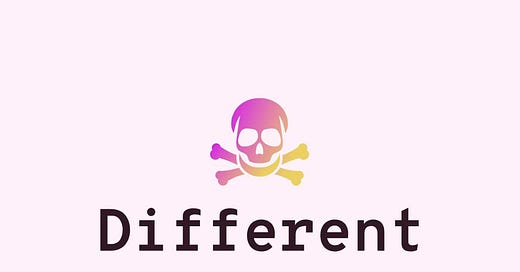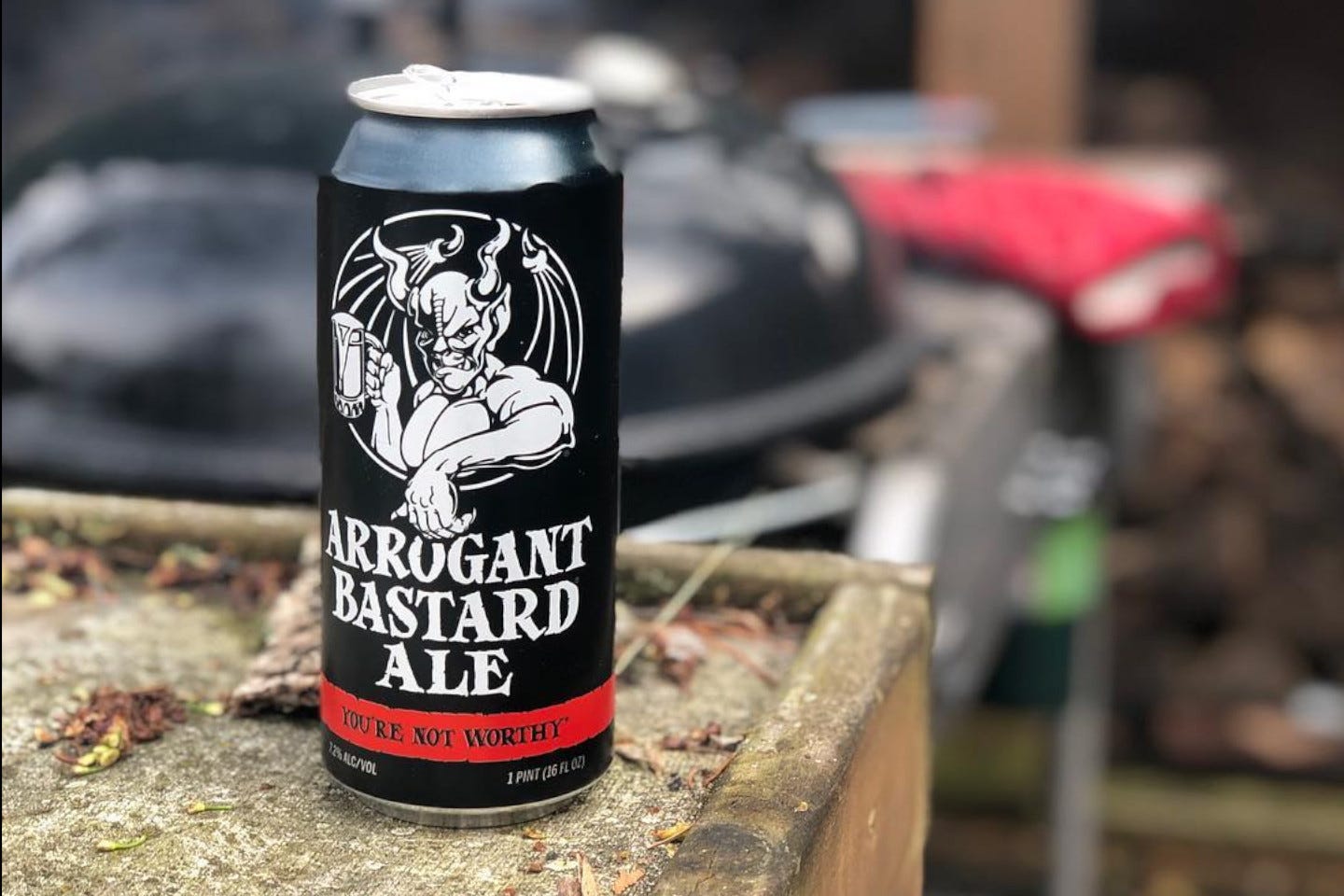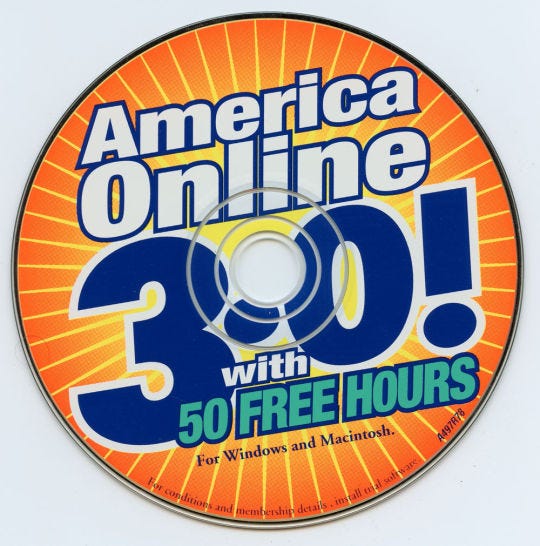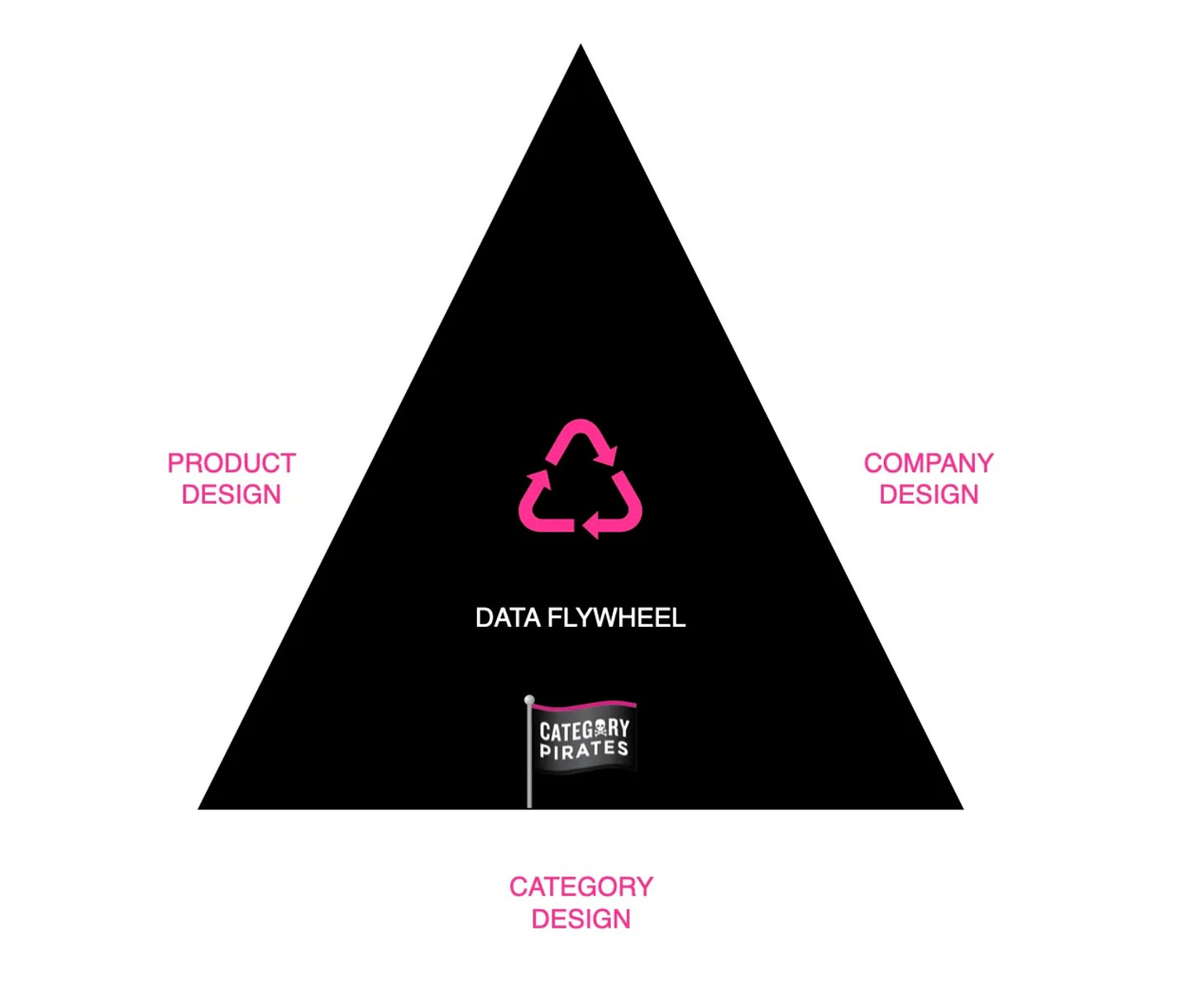David Sacks: 3 Secrets To Billion Dollar Startups, Marketing Who You're Not For, Everyone Is (not) A Marketing Expert, & Pirate Snacks
Thanks for reading 🙏
Welcome to The Different Newsletter.
Musings for entrepreneurs, marketing leaders, and creators with a different mind.
From Christopher Lochhead.
Sponsored by Bad Tuna Industries.
(This special addition Different Newsletter is being published on the first Friday in August to ensure the fewest possible people read it.)
🏴☠️
Marketing Who You’re Not For
Negative reviews might be the most underused, radically different, stand out marketing.
First.
They’re fucking funny.
Every time 😎
Second, declaring who you’re not for, can be more powerful that marketing who are are for.
Legendary marketing attracts who you want to attract, and repels who you don’t want to attract.
(Force a choice, not a comparison.)
For example, my personal website:
One of my favorite executions of this strategy is Arrogant Bastard beer from Stone Brewing in San Diego.
First.
They named it Arrogant Bastard.
(Legendary ☠️)
Second, this is their logo 👇🏻
Third, their tag line is, “you’re not worthy”.
And the copy on their website and packaging is all time:
“This is an aggressive beer. You probably won’t like it.
It is quite doubtful that you have the taste or sophistication to be able to appreciate an ale of this quality and depth.
We would suggest that you stick to safer and more familiar territory—maybe something with a multimillion-dollar ad campaign aimed at convincing you it’s made at an independent brewery, or one that implies that their tasteless seltzer / fizzy yellow beer / whatever-the-hell will give you more sex appeal.
Perhaps you think multimillion-dollar ad campaigns make all that junk taste better.
Perhaps you’re mouthing your words as you read this.”
My buddy Brent recently texted me this legendary example 😎☠️
Most people will never summon the courage to execute this marketing tactic.
That makes it a massive advantage for those who do.
🏴☠️
Everyone is (not) a marketing expert.
The lens for evaluating marketing
People tend to treat marketing just like any other form of content.
They apply the same lens to marketing that they apply to a movie, a book, or naming their cat:
“Do I like it?”
For example, I was once in a meeting where a CMO was proposing a new color pallet for the company brand, which included orange.
The second the CEO saw the new colors, he grizzled.
“ORANGE!?”
“Don’t you know that ORANGE makes people angry!?”
I’m not aware of any data science that shows this, but we sure know orange makes one guy angry!
The “do I like it” lens is for fools.
The “do I like it” lens is for fools.
The “do I like it” lens is for fools.
Yet, it is the lens most used when evaluating marketing.
But a more powerful lens is, “Does this work?”
And by “work” we mean:
Drive near, mid and long term revenue
Design and dominate a category of your choosing
Drive legendary word-of-mouth
That’s the lens to evaluate marketing plans, campaigns, and executions — and it turns out very few people are trained, experienced, in using the “Does this work” lens.
(As a result Marketing leaders get a lot of help from many others who use the “do I like it” lens.)
So, when next looking at a new marketing strategy or plan, try the “Does this work?” lens.
And watch your revenue and category grow like Bacillus stearothermophilus.
(Its a bacteria that can double in size every 10 minutes.)
And don’t forget to…..
Check out the new Strategy Therapy course from Category Pirates.
And learn how to create a one page category strategy.
🏴☠️
Random Pirates Thoughts
If everyone thinks you have a great idea for a startup.
You probably have a shitty idea.
Crypto startups to see $12 billion of venture capital funding in 2024
“You’re remembered for the rules you break.”
Phil Knight, Nike founder
Moderna CEO says AI will help scientists understand ‘most diseases’ in 3 to 5 years
Crypto startups to see $12 billion of venture capital funding in 2024
Soon there will be two kinds of companies: AI companies, and companies who are no longer with us.
India's $45 Billion Startup Implosion Puts Tech Future in Doubt
There is a massive accountant shortage
M&A is down through the first half of 2024,
Only 904 deals involving startups
There were more than 1,000 in H1 last year.
Venture capital has a (big) exit problem
Billion-dollar “exits” by US tech start-ups number only 16 so far this year, compared with 211 in all of 2021
Never forget. B2B buyers are also Cs.
Which makes all marketing B2C marketing.
"Dreams don't work unless you do."
Simone Biles, Legendary American
🏴☠️
David Sacks: 3 Secrets To Building Billion Dollar Startups
David Sacks is one of the all-time great entrepreneurs. He’s the founder and CEO of Yammer, which sold to Microsoft for a cool $1.2 billion.
He was also on the original team at PayPal (Sacks is part of the “PayPal Mafia” with Elon Musk, Peter Thiel, Reid Hoffman, Roelof Botha, etc) and an angel investor in Facebook, Airbnb, and SpaceX.
Now, he’s having success in VC at Craft Ventures.
And as a podcaster on the “All In” show.
David’s been on my podcast a few times and he’s shared with me one way founders can go viral is to focus on their product hook rather than their value proposition.
So, how strong the hook — or viral attention — your company gets initially is a good barometer for how successful it will be.
David insights about how to recognize, and create, a successful business are priceless.
1. Hone in on your product hook.
Just as a hit song needs a catchy chorus (Hey! Ho! Let’s go!), your product needs a hook if you want to build an extraordinary company.
Without a hook, nobody will engage with your product, and potential customers won’t get the chance to discover the value you bring.
When David’s considering whether to invest in a startup, the first thing he does is look for the product hook — a simple and repeatable transaction, flow, or behavior.
Think of it as the search box for Google, the status update for Twitter, or sending a friend request on Facebook.
The simpler and more discrete, the better.
A lot of founders layer on a bunch of complexity too early.
Think additional features, extra services, premium options.
But the problem with complicating your hook too soon is users need to be engaged with your product before they’re willing to grow with you.
Before he started Yammer, David had been bouncing around the idea to create a corporate social network for a year.
But it wasn’t until Twitter launched that he realized what the hook should be: the status update, but for the workplace.
BAM!
Once he realized what to center the product on — and, in turn, how he’d get users on board — he started Yammer.
At this time, “freemium” in the enterprise space was still pretty new as a hook.
And he is a pioneer because he used this expertly.
2. Innovate on distribution, not just product.
But it’s not enough to have an enticing product.
Really great companies also have a distribution trick.
Something to enable them to grow at an explosive rate.
David has done a genius job of managing explosive distribution with many ventures.
At PayPal, for instance, he embedded PayPal logos on eBay auctions to accelerate growth.
And you could owe money to somebody who didn’t have a PayPal account, which attracted new users.
With Yammer, he allowed individuals to sign up directly, rather than asking their company’s IT department for permission.
Manoj Bhargava the founder of 5-Hour Energy convinced grocery chains and connivance stores to put his product (not just) in the drink aisle.
But, at the cash register.
That one move, made a giant difference.
Same thing for Sean Riley, CEO of Dude Wipes.
Originally they were placed in the men’s products section of stores.
Sales were lackluster.
But, when they were placed next to toilet paper.
BOOM 📈
Sales took off.
Back in the day.
American Online (AOL) became the category king of the early days of the consumer Internet by giving away CDs (an ancient approach to getting apps and data installed on a computer) with every thing from cereal boxes, to in-flight meals on planes, to even Omaha Steak packages.
They brought their product to the masses (not to geeks).
Over time they gave away over a billion AOL CDs.
By blanketing the analog world, they populated the digital world.
My friend, John Bielenberg, the legendary designer, would call these distribution tricks,
“Looking for a dog with a hat.”
If we’re walking down the street, there’s a thousand normal things we won’t notice — signs, pedestrians, cars.
So when there’s something unusual, like a dog with a hat, people naturally notice.
Often, a different distribution strategy works.
3. Design opportunities to go viral early.
A lot of founders think good marketing is the key to making a product massively successful.
But making your company go viral requires more than just the right story: you must thoughtfully build your business from the bottom up and design plenty of opportunities for virality.
David has a saying: “architecture is destiny.”
In other words, how you structure your product determines how it can grow — and it’s much easier to get it right from the beginning than to change your blueprint later.
Because he strategically designed Yammer’s software to be cloud-based from the beginning, the product won out over similar companies that had to course correct down the road.
It was a fundamental part of the company from the start.
We see this today with AI startups, Vs. large incumbents moving into the mega AI category.
So far, the newer companies like OpenAI and Nvidia are the big winners.
Not only did they pioneer at the category level, they built native AI architected technology.
This happens with every major platform category shift.
Legacy companies have to jerry rig their existing products, to work in the new category architecture.
As a VC, David has realized many tech startups either work quickly or not all.
There’s little to no in-between.
(Although it does happen 😎)
PayPal and Yammer were both under four years old when he sold them to eBay and Microsoft, respectively.
There’s no simple recipe for creating a legendary business.
But, designing a breakthrough product, category and company (distribution model) with the goal of driving WOM - word of mouth, (aka going viral) are worthy of meaningful discussion, analysis and thought.
🏴☠️
Shalom my Pirate friend,
👊🏴☠️🙏
Here come the dis-credits.
Pirate Snacks ☠️
And Legal Warnings…..
The creator of this Different Newsletter failed cutting & folding in kindergarten.
People who subscribe on Substack get this Different newsletter first.
Copyright Category Pirates, LLC
#NeverAgainIsNow 🇮🇱
#SaveGazaFromHamas
All newsletters contain nuts 🐿
This Different newsletter contains content known to The State of California that causes radically different futures, new category designs, legendary careers, and upset readers.
The State of Youdahoe has declared (by law) Category Pirates New Strategy Therapy a must take course for CEOs, Founders & Marketers
The creator of this Different Newsletter:
-does not possess a GED
-can’t find his car
-is friendly with Mary Jane
-was thrown out of school at 18
-gets lost driving with nav on
-has been fired more times than he can count
-possess multiple learning differences
(aka superpowers)
There are grammer and spelling miskes all over this newsleter.
It’s a feature.
Because Lochhead is to lazy and cheap to hire an editor.
Most Marketers and Entrepreneurs think the market is like weather… it just happens…. no one ever told them…
…, market categories can be designed 😎
Hi Karin 👋
Bigfoot sighting alleged in resurfaced nature documentary footage
Texas football coach marries stripper nicknamed 'pole assassin' who owns an emotional support pet monkey
Substack thinks this newsletter is too long.
Those sexy/naughty French: Awkward moment French President Macron and sports minister share ‘strange kiss’ during Olympics
An AI-powered (fake) attorney? Man accused of posing as lawyer may have used tech for filings
The Olympics Gave Each Team USA Track Athlete 21 Condoms for 19 Days. It May Not Be Enough.
Oscar Mayer Wienermobile Crashes Along Chicago Area Highway
Furious fans rip into a 'ridiculous' Olympic event
Dealing with bats? Here’s what to know
You do know, his real newsletter Category Pirates is much more professional.
Yes, this newsletter is really crap-o-ll-a.
Ever notice how much funner words are when you throw o-ll-a at the end of them!
Is funner a word?
Like, say for example.
Dinner-o-ll-a.
Dinner-o-ll-a?
No one’s ever said that.
You know… a dinner-oll-a.
The rolla, you eat with dinner.
That’s (just) called a dinner role, you donkey!
Ya, but when you say dinner-oll-a, it makes it more funner.
Stop it.
Did you know there is an Olla company?
But, I though o-ll-a was Spanish for “hello”.
No, you moron that’s Hola!!!
Which is sometimes followed up by, Cómo estás?
Why are you giving me a Spanish lesson, all of a sudden?
Well, you brought up the o-ll-a stuff in the first place.
Ok, well,…. what about about o-rama.
Ya! I love o-rama.
Shop-o-rama.
Pant-o-rama.
Bowl-o-rama.
Ram Trucks-o-rama.
That’s not a real o-rama brand.
No such think as ram-o-rma’s!
You’re making stuff up.
Who says we can’t make stuff up?
We?
What’s going on here?
Who am I talking to?
This fucking newsletter is making me talk to myself, in my own head!
Again!
Can a newsletter make you nuts?
This one can.
🏴☠️
Hey, thanks for hanging out for the extra (silly) Pirate Snacks at the end...
….let's hang out again soon 😎☠️🙏
Published by Category Pirates.
Sponsored By Bad Tuna Industries.
Makers of Bad Tuna Foot Cream.











